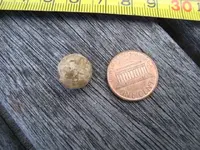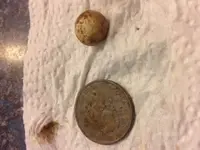You are using an out of date browser. It may not display this or other websites correctly.
You should upgrade or use an alternative browser.
You should upgrade or use an alternative browser.
Musket ball?
- Thread starter moeferg
- Start date
ConnerBates123
Jr. Member
Definitely a possibility that it is a musket ball...was the signal you got from this item or from other metal around it? If the signal wasn't from that item, it may be an old clay marble?
sutphin
Gold Member
- Joined
- Oct 2, 2013
- Messages
- 8,344
- Reaction score
- 4,467
- Golden Thread
- 0
- Location
- brunswick md
- Detector(s) used
- WHITES 5900, MXT 300, MXT PRO, MXT ALL PRO/ 8X6 SEF COIL
- Primary Interest:
- Relic Hunting
MY OLD MUSKET BALL OR MY RED RUBBER BALL CANT REMEMBER .
Davers
Gold Member
- Joined
- Jan 8, 2013
- Messages
- 8,217
- Reaction score
- 7,277
- Golden Thread
- 0
- Location
- N.of , I-285...GA
- Detector(s) used
- Whites Spc xlt & Tesoro Tejon- Now back ...Fisher 1266-X. TRX Pointer. New .Teknetics G2 + . New AT Pro .
- Primary Interest:
- All Treasure Hunting
Looks about right to me as well.
Tho an exact measurement would help a-lot.
What State U in?
Tho an exact measurement would help a-lot.
What State U in?
Old Dude
Gold Member
- Joined
- Feb 20, 2013
- Messages
- 8,799
- Reaction score
- 9,849
- Golden Thread
- 0
- Location
- Luzerne County, Pa
- 🏆 Honorable Mentions:
- 2
- Detector(s) used
- Fisher F75, Garrett ATPro, Garrett GTAx 500
- Primary Interest:
- Metal Detecting
Definitely looks the part. Weigh it in grains if you can and measure it. Some of these guys can give you the caliber.
.490-.495 are common 50 cal.. A ten to fifteen thousandths avg. lubed cloth patch takes up the slack and functions as a gas seal.
Paper during colonial times and some later were part of a preload that substituted for a cloth patch but were for throwing lots of lead more than pinpoint accuracy..
Could be musket, though at the lighter end of the spectrum.
The flat is likely the sprue area. After trimming an additional process could be added to roll the cast balls to reduce the sprue but loading it up or down in the bore would allow a generous nub without a problem.
I would call it a rifle ball, unfired, but what ever it was intended to be used in congrats!
Paper during colonial times and some later were part of a preload that substituted for a cloth patch but were for throwing lots of lead more than pinpoint accuracy..
Could be musket, though at the lighter end of the spectrum.
The flat is likely the sprue area. After trimming an additional process could be added to roll the cast balls to reduce the sprue but loading it up or down in the bore would allow a generous nub without a problem.
I would call it a rifle ball, unfired, but what ever it was intended to be used in congrats!
Last edited:
Msbeepbeep
Platinum Member
Nice! Congrats!
l.cutler
Silver Member
Too small for a musket, no muskets were smaller than .69 caliber. Most likely a rifle or pistol ball, no way to say for sure though.
Simon1
Gold Member
When I was younger, we use to fish on the river down by our house and my parents use to tell us that a band of Indians had been camped out here and that there was a battle. Can't remember if it was Indians attacking Indians or Indians and the Whiteman. Anyway, we use to find these buried in the clay hill alongside the river. At the time, we never gave it much thought. This was suppose to be about 200 yards or so away from an old Clovis mound.
trikikiwi
Silver Member
- Joined
- Oct 5, 2006
- Messages
- 3,544
- Reaction score
- 655
- Golden Thread
- 0
- Location
- New Zealand
- Detector(s) used
- Minelab Sovereign GT
- Primary Interest:
- All Treasure Hunting
I found this last night. It was about 7" deep. It measures right around .50 and has a small flat on one side. Any thoughts?
That looks exactly like my first, so far, only Ball shot, that I have detected.
I found mine within the area of a known conflict in NZ in the 1860's.
Edit: I found a pic of mine, found in 2009

Cheers, Mike
Last edited:
ArDirtSlinger
Hero Member
I vote rifle ball also.. I've found several in my area..
Is there any way to tell the difference between a fired musket ball vs a fired rifle ball?
For me, by how the ball looks after firing ,not really.
A rifle usually a looser fit due to rifling grooves.
An oversized ball pounded in might leave rifling marks.
Most are upset(out of round) after/from firing, into even a soft medium and can show fabric marks from patch material but a rifle may not leave rifling marks unless a very tight fit. Powder charge amount will figure into how upset the projectile becomes in the bore too and if ball gets swaged into some of the grooves.
A lubed patch protects it to a point.
There are some fifty caliber range smooth bores today.... kinda custom though.
Fifty four to .58 were common trade gun(smoothbore anyway) sizes around 1800.
Because a smooth bore,musket or trade gun could use shot or roundball the bore size was often greater than that of a fifty caliber rifle to allow a greater sized payload of shot.
A .62 is near twenty gauge. About as small a smoothbore I would be interested in.
So while there are exceptions with there being some very large rifle bores,and there are some small smoothbores; the majority of larger smooth bore vs smaller rifle bores
makes size of a roundball a way to guess at it's use; in the very near fifty caliber range more so.
Last edited:
Similar threads
- Replies
- 9
- Views
- 585
- Replies
- 5
- Views
- 462
Users who are viewing this thread
Total: 1 (members: 0, guests: 1)




